On the High-Temperature Oxidation and Area Specific Resistance of New Commercial Ferritic Stainless Steels
Abstract
1. Introduction
2. Materials and Methods
2.1. Materials
2.2. Weight Gain Measurements
2.3. Area Specific Resistance Measurements
- galvanostatic Electrochemical Impedance Spectroscopy (EIS) at 500 μA in the frequency range between 600 KHz–200 mHz;
- repetition of the measurement every five hours until the measured resistance was stable.
2.4. Cross-Sections Preparation and Chemical and Morphological Characterization
- SEM through a ZEISS EVO 40 SEM (Carl Zeiss, Oberkochen, Germany)
- ○
- SEM micrographs, showing the morphology of the oxide scales and the elements distribution, were obtained using 20 kV of acceleration voltage, a working distance of 12 mm, and the secondary electrons (SE) detector;
- XRD with a Philips X’Pert 1 diffractometer (Malvern Pananalytical, Malvern, UK) with Bragg–Brentano geometry
- ○
- XRD data were collected using 40 kV of acceleration voltage, a current of 30 mA, and the CuKα radiation (λ = 1.5406 Å); diffractograms were recorded from 15 to 80° 2θ, in 0.0250° 2θ increments with 5.0 s counting time per increment;
- μ-RS with a Jasco NRS-4100 spectrometer (Jasco, Easton, MD, USA)
- ○
- μ-RS spectra were acquired using a green laser (λ = 532 nm); the samples were observed with a 20× or 100× objective and exposed to a laser beam with a power from 0.7 to 7 mW at the sample surface. The Raman spectrometer was operated using continuous scanning mode in the spectral window from 100 to 4000 cm−1.
3. Results
3.1. Weight Gain and ASR Measurements
3.2. Chemical and Morphological Characterization of Surfaces and Cross-Sections
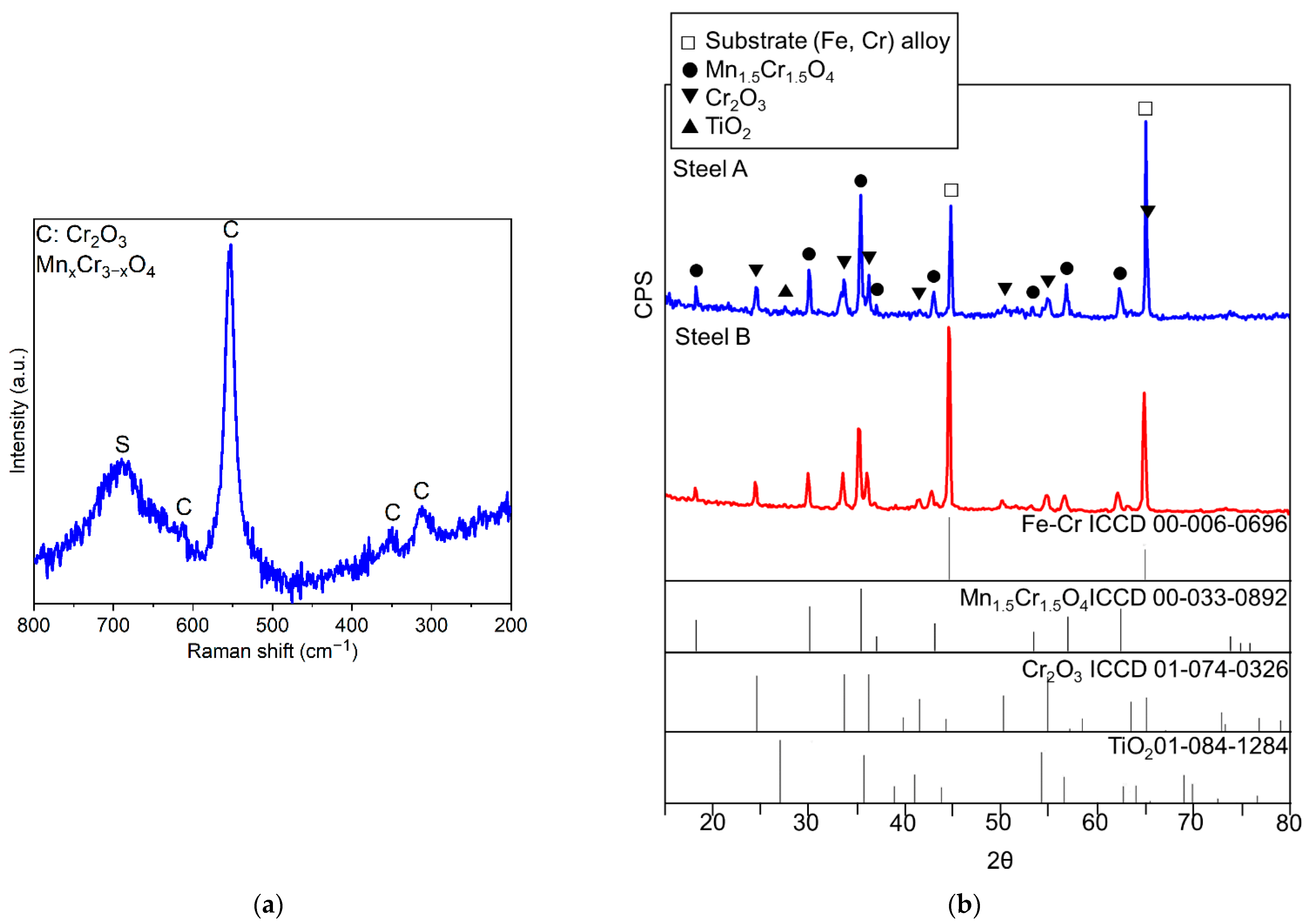
- Ti has two zones of concentration, the first, smaller, is at the interface between the scale and the metal substrate, the second and major one, is at the external part of the TGO (Figure 10b,c);
- Al shows a maximum concentration in the inner layer of the oxide scale (Figure 10b,e)
- Si is primarily distributed inside the alloy and forms a thin layer just before the first peak of Ti (Figure 10b,f).
- Ti and particularly Al seem to be more concentrated at the interface TGO/FSS according to the EDS map and the EDS quantitative profile, respectively (Figure 11d,b); for Al, the EDS map also shows the element distribution inside the TGO and at the metal substrate edge where Al rich oxides are precipitating within the matrix (Figure 11f);
4. Discussion
5. Conclusions
- Steel A and Steel B have a similar oxidation behavior compatible with that of AISI 441 FSS, which is a standard material used as IC for IT-SOFC. Steel B exhibits slightly lower values of weight gain compared with Steel A. Such difference could be explained by the presence, in Steel B, of adequate amounts of Nb and Mo in addition to a larger Cr content. This element offers a higher resistance to high-temperature oxidation, whereas Mo and Nb contribute to control the diffusion of elements at the alloy grain boundaries by forming Laves phases;
- All samples are characterized by TGOs mainly consisting of an inner Cr2O3 subscale and an outer Cu-doped (Mn,Cr)3O4 spinel layer. The presence of a discontinuous TiO2 scale, that can serve as a barrier to Cr evaporation reaction, was observed in steel A;
- The ASR values measured on both steels are higher than those typical of suitable FSS for ICs. Such a result could be explained by the presence of elements such as Al and Si, which form resistive oxides mainly disposed at the alloy/TGO interface.
- Compositional improvements of the studied steels are required for their application as ICs in SOFC stacks. In particular, the substitution or the adjustment of Si and Al content is necessary to enhance the electrical conductivity of the TGO.
Author Contributions
Funding
Institutional Review Board Statement
Informed Consent Statement
Acknowledgments
Conflicts of Interest
References
- Shri Prakash, B.; Pavitra, R.; Senthil Kumar, S.; Aruna, S.T. Electrolyte bi-layering strategy to improve the performance of an intermediate temperature solid oxide fuel cell: A review. J. Power Sources 2018, 381, 136–155. [Google Scholar] [CrossRef]
- Da Silva, F.S.; De Souza, T.M. Novel materials for solid oxide fuel cell technologies: A literature review. Int. J. Hydrogen Energy 2017, 42, 26020–26036. [Google Scholar] [CrossRef]
- Aruna, S.T.; Balaji, L.S.; Senthil Kumar, S.; Shri Prakash, B. Electrospinning in solid oxide fuel Cells—A review. Renew. Sustain. Energy Rev. 2017, 67, 673–682. [Google Scholar] [CrossRef]
- Mahmud, L.S.; Muchtar, A.; Somalu, M.R. Challenges in fabricating planar solid oxide fuel cells: A review. Renew. Sustain. Energy Rev. 2017, 72, 105–116. [Google Scholar] [CrossRef]
- Li, J.; Zhang, W.; Yang, J.; Yan, D.; Pu, J.; Chi, B.; Jian, L. Oxidation behavior of metallic interconnect in solid oxide fuel cell stack. J. Power Sources 2017, 353, 195–201. [Google Scholar] [CrossRef]
- Niewolak, L.; Tietz, F.; Quadakkers, W.J. Interconnects. In High-Temperature Solid Oxide Fuel Cells for the 21st Century Fundamentals, Design and Applications, 2nd ed.; Kendall, K., Kendall, M., Eds.; Elsevier: London, UK, 2016; pp. 195–254. [Google Scholar]
- Ravi Chandran, P.; Arjunan, T.V. A review of materials used for solid oxide fuel cell. Int. J. Chem. Technol. Res. 2015, 7, 488–497. [Google Scholar]
- Mahato, N.; Banerjee, A.; Gupta, A.; Omar, S.; Balani, K. Progress in material selection for solid oxide fuel cell technology: A review. Prog. Mater. Sci. 2015, 72, 141–337. [Google Scholar] [CrossRef]
- Safikhani, A.; Esmailian, M.; Tinatiseresht, T.; Barati Darband, G. High temperature cyclic oxidation behavior of ferritic stainless steel with addition of alloying elements Nb and Ti for use in SOFCs interconnect. Int. J. Hydrogen Energy 2016, 41, 6045–6052. [Google Scholar] [CrossRef]
- Öztürk, B.; Topcu, A.; Öztürk, S.; Cora, Ö.N. Oxidation, electrical and mechanical properties of Crofer®22 solid oxide fuel cell metallic interconnects manufactured through powder metallurgy. Int. J. Hydrogen Energy 2018, 43, 10822–10833. [Google Scholar] [CrossRef]
- Qi, Q.; Wang, L.; Liu, Y.; Huang, Z. Oxidation resistance optimization of TiC/hastelloy composites by adding Ta element applied for intermediate temperature solid oxide fuel cell interconnects. J. Power Sources 2018, 401, 1–5. [Google Scholar] [CrossRef]
- Mah, J.C.W.; Muchtara, A.; Somalu, M.R.; Ghazali, M.J. Metallic interconnects for solid oxide fuel cell: A review on protective coating and deposition techniques. Int. J. Hydrogen Energy 2017, 42, 9219–9229. [Google Scholar] [CrossRef]
- Swaminathan, S.; Ko, Y.S.; Lee, Y.-S.; Kim, D.-I. Oxidation behavior and area specific resistance of La, Cu and B alloyed Fe-22Cr ferritic steels for solid oxide fuel cell interconnects. J. Power Sources 2017, 369, 13–26. [Google Scholar] [CrossRef]
- Lenka, R.K.; Patro, P.K.; Sharma, J.; Mahat, T.; Sinha, P.K. Evaluation of La0.75Sr0.25Cr0.5Mn0.5O3 protective coating on ferritic stainless steel interconnect for SOFC application. Int. J. Hydrogen Energy 2016, 41, 20365–20372. [Google Scholar] [CrossRef]
- Ryter, J.; Amendola, R.; McCleary, M.; Shong, W.-J.; Liu, C.-K.; Spotorno, R.; Piccardo, P. Effect of electrical current on the oxidation behavior of electroless nickel-plated ferritic stainless steel in solid oxide fuel cell operating conditions. Int. J. Hydrogen Energy 2018, 43, 426–434. [Google Scholar] [CrossRef]
- Wang, R.; Sun, Z.; Pal, U.B.; Gopalan, S.; Basu, S.N. Mitigation of chromium poisoning of cathodes in solid oxide fuel cells employing CuMn1.8O4 spinel coating on metallic interconnect. J. Power Sources 2018, 376, 100–110. [Google Scholar] [CrossRef]
- Kim, B.K.; Kim, D.-I.; Yi, K.-W. Suppression of Cr evaporation by Co electroplating and underlying Cr retention mechanisms for the 22 wt.% Cr containing ferritic stainless steel. Corros. Sci. 2018, 130, 45–55. [Google Scholar] [CrossRef]
- Piccardo, P.; Pecunia, A.; Bongiorno, V.; Spotorno, R.; Wuillemin, Z.; Ouweltjes, J.P. Ageing of materials at inlet and outlet fuel manifolds in a SOFC stack. ECS Trans. 2015, 68, 2611–2624. [Google Scholar] [CrossRef]
- Spotorno, R.; Piccardo, P.; Schiller, G. Effect of cathode contacting on anode supported cell performances. J. Electrochem. Soc. 2016, 163, F872–F876. [Google Scholar] [CrossRef]
- Zhang, X.; Yu, G.; Zeng, S.; Parbey, J.; Xiao, S.; Li, B.; Lia, T.; Andersson, M. Mechanism of chromium poisoning the conventional cathode material for solid oxide fuel cells. J. Power Sources 2018, 381, 26–29. [Google Scholar] [CrossRef]
- Jiang, S.P.; Chen, X. Chromium deposition and poisoning of cathodes of solid oxide fuel Cells—A review. Int. J. Hydrogen Energy 2014, 39, 505–531. [Google Scholar] [CrossRef]
- Yang, Z.; Guo, M.; Wang, N.; Ma, C.; Wang, J.; Han, M. A short review of cathode poisoning and corrosion in solid oxide fuel cell. Int. J. Hydrogen Energy 2017, 42, 24948–24959. [Google Scholar] [CrossRef]
- Amezawa, K.; Shindo, Y.; Fujimaki, Y.; Kimura, Y.; Nakamura, T.; Iguchi, F.; Yashiro, K.; Yugami, H.; Kawada, T. Mechanism of chromium poisoning in SOFC cathode investigated by using pattern thin film model electrode. ECS Trans. 2017, 78, 965–970. [Google Scholar] [CrossRef]
- Park, M.; Shin, J.-S.; Lee, S.; Kim, H.-J.; An, H.; Ji, H.-I.; Kim, H.; Son, J.-W.; Lee, J.-H.; Kim, B.-K.; et al. Thermal degradation mechanism of ferritic alloy (Crofer 22 APU). Corros. Sci. 2018, 134, 17–22. [Google Scholar] [CrossRef]
- Sachitanand, R.; Sattari, M.; Svensson, J.-E.; Froitzheim, J. Evaluation of the oxidation and Cr evaporation properties of selected FeCr alloys used as SOFC interconnects. Int. J. Hydrogen Energy 2013, 38, 15328–15334. [Google Scholar] [CrossRef]
- Talic, B.; Molin, S.; Hendriksen, P.V.; Lein, H.L. Effect of pre-oxidation on the oxidation resistance of Crofer 22 APU. Corros. Sci. 2018, 138, 189–199. [Google Scholar] [CrossRef]
- Bredvei Skilbred, A.W.; Haugsrud, R. The effect of dual atmosphere conditions on the corrosion of Sandvik sanergy HT. Int. J. Hydrogen Energy 2012, 37, 8095–8101. [Google Scholar] [CrossRef]
- Hosseini, N.; Karimzadeh, F.; Abbasi, M.H.; Choi, G.M. Correlation between microstructure and electrical properties of Cu1.3Mn1.7O4/La2O3 composite-coated ferritic stainless steel interconnects. J. Alloys Compd. 2016, 673, 249–257. [Google Scholar] [CrossRef]
- Cooper, L.; Benhaddad, S.; Wood, A.; Iveya, D.G. The effect of surface treatment on the oxidation of ferritic stainless steels used for solid oxide fuel cell interconnects. J. Power Sources 2008, 184, 220–228. [Google Scholar] [CrossRef]
- Bongiorno, V.; Piccardo, P.; Anelli, S.; Spotorno, R. Influence of surface finishing on high-temperature oxidation of AISI type 444 ferritic stainless steel used in SOFC stacks. Acta Metall. Sin. Engl. 2017, 30, 697–711. [Google Scholar] [CrossRef]
- Belogolovsky, I.; Hou, P.Y.; Jacobson, C.P.; Visco, S.J. Chromia scale adhesion on 430 stainless steel: Effect of different surface treatments. J. Power Sources 2008, 182, 259–264. [Google Scholar] [CrossRef]
- Ranjbar-Nouri, Z.; Soltanieh, M.; Rastegari, S. Applying the protective CuMn2O4 spinel coating on AISI-430 ferritic stainless steel used as solid oxide fuel cell interconnects. Surf. Coat. Technol. 2018, 334, 365–372. [Google Scholar] [CrossRef]
- Waluyo, N.S.; Park, S.-S.; Song, R.-H.; Lee, S.-B.; Lim, T.-H.; Hong, J.-E.; Ryu, K.H.; Im, W.B.; Lee, J.-W. Protective coating based on manganese–copper oxide for solid oxide fuel cell interconnects: Plasma spray coating and performance evaluation. Ceram. Int. 2018, 44, 11576–11581. [Google Scholar] [CrossRef]
- Swaminathan, S.; Lee, Y.-S.; Kim, D.-I. Effects of alloyed La, Cu and B on the oxidation of Fe-22Cr ferritic stainless steels under simulated cathode side atmosphere of solid oxide fuel cell interconnects. Corros. Sci. 2018, 133, 150–164. [Google Scholar] [CrossRef]
- Zhu, W.Z.; Deevi, S.C. Opportunity of metallic interconnects for solid oxide fuel cells: A status on contact resistance. Mater. Res. Bull. 2003, 38, 957–973. [Google Scholar] [CrossRef]
- Hamada, J.I.; Kanno, N.; Hayashi, A.; Hiraide, N.; Abe, M.; Nishimura, K.; Takushima, C.; Yakawa, A.; Fudanoki, F. Development of new ferritic stainless steel sheets with excellent heat resistance and formability for automotive exhaust manifolds. Metall. Ital. 2018, 5, 33–39. [Google Scholar]
- Goebel, C.; Alnegren, P.; Faust, R.; Svensson, J.-E.; Froitzheim, J. The effect of pre-oxidation parameters on the corrosion behavior of AISI 441 in dual atmosphere. Int. J. Hydrogen Energy 2018, 43, 14665–14674. [Google Scholar] [CrossRef]
- Sabato, A.G.; Chrysanthou, A.; Salvo, M.; Cempura, G.; Smeacetto, F. Interface stability between bare, MnCo spinel coated AISI 441 stainless steel and a diopside-based glass-ceramic sealant. Int. J. Hydrogen Energy 2018, 43, 1824–1834. [Google Scholar] [CrossRef]
- Alnegren, P.; Sattari, M.; Svensson, J.-E.; Froitzheim, J. Severe dual atmosphere effect at 600 °C for stainless steel 441. J. Power Sources 2016, 301, 170–178. [Google Scholar] [CrossRef]
- Kumar, V.; Kaur, G.; Lu, K.; Pickrell, G. Interfacial compatibility of alumino-borosilicate glass sealants with AISI 441 and YSZ for different atmospheres. Int. J. Hydrogen Energy 2015, 40, 1195–1202. [Google Scholar] [CrossRef]
- Lee, K.; Yoon, B.; Kang, J.; Lee, S.; Bae, J. Evaluation of Ag-Doped (MnCo)3O4 spinel as a solid oxide fuel cell metallic interconnect coating material. Int. J. Hydrogen Energy 2017, 42, 29511–29517. [Google Scholar] [CrossRef]
- Piccardo, P.; Anelli, S.; Bongiorno, V.; Spotorno, R.; Repetto, L.; Girardon, P. K44M ferritic stainless steel as possible interconnect material for SOFC stack operating at 600 °C: Characterization of the oxidation behavior at early working stages. Int. J. Hydrogen Energy 2015, 40, 3726–3738. [Google Scholar] [CrossRef]
- Grolig, J.G.; Froitzheim, J.; Svensson, J.E. Coated stainless steel 441 as interconnect material for solid oxide fuel cells: Oxidation performance and chromium evaporation. J. Power Sources 2014, 248, 1007–1013. [Google Scholar] [CrossRef]
- Grolig, J.G.; Froitzheim, J.; Svensson, J.E. Coated stainless steel 441 as interconnect material for solid oxide fuel cells: Evolution of electrical properties. J. Power Sources 2015, 284, 321–327. [Google Scholar] [CrossRef]
- Talic, B.; Venkatachalam, V.; Hendriksen, P.V.; Kiebach, R. Comparison of MnCo2O4 coated crofer 22 H, 441, 430 as interconnects for intermediate-temperature solid oxide fuel cell stacks. J. Alloys Compd. 2020, 821, 153229–153240. [Google Scholar] [CrossRef]
- Bianco, M.; Ouweltjes, J.P.; Van Herle, J. Degradation analysis of commercial interconnect materials for solid oxide fuel cells in stacks operated up to 18,000 h. Int. J. Hydrogen Energy 2019, 44, 31406–31422. [Google Scholar] [CrossRef]
- Spotorno, R. High-Temperature oxidation of AISI441 ferritic stainless steel for solid oxide fuel cells. Mater. Sci. Forum 2021, 1016, 1381–1385. [Google Scholar] [CrossRef]
- Niu, Y.; Gesmundo, F.; Viani, F.; Douglass, D.L. The air oxidation of two phase Cu-Cr alloys at 200–900 °C. Oxid. Met. 1997, 48, 357–380. [Google Scholar] [CrossRef]
- Madern, N.; Monnier, J.; Baddour-Hadjean, R.; Steckmeyer, A.; Joubert, J.-M. Characterization of refractory steel oxidation at high temperature. Corros. Sci. 2018, 132, 223–233. [Google Scholar] [CrossRef]
- Hosterman, B.D. Raman Spectroscopic Study of Solid Solution Spinel Oxides. Ph.D. Thesis, University of Nevada, Las Vegas, NV, USA, 2011. [Google Scholar]
- Srisrual, A.; Coindeau, S.; Galerie, A.; Petit, J.-P.; Wouters, Y. Identification by photoelectrochemistry of oxide phases grown during the initial stages of thermal oxidation of AISI 441 ferritic stainless steel in air or in water vapour. Corros. Sci. 2009, 51, 562–568. [Google Scholar] [CrossRef]
- Safikhani, A.; Esmailian, M.; Salmani, M.R.; Aminfard, M. Effect of Ni-Mo addition on cyclic and isothermal oxidation resistance and electrical behavior of ferritic stainless steel for SOFCs interconnect. Int. J. Hydrogen Energy 2014, 39, 11210–11223. [Google Scholar] [CrossRef]
- Horita, T.; Kishimoto, H.; Yamaji, K.; Xiong, Y.; Sakai, N.; Brito, M.E.; Yokokawa, H. Evaluation of laves-phase forming Fe-Cr alloy for SOFC interconnects in reducing atmosphere. J. Power Sources 2008, 176, 54–61. [Google Scholar] [CrossRef]
- Key, C.; Eziashi, J.; Froitzheim, J.; Amendola, R.; Smith, R.; Gannon, P. Methods to quantify reactive chromium vaporization from solid oxide fuel cell interconnects. J. Electrochem. Soc. 2014, 161, C373–C381. [Google Scholar] [CrossRef]
- Rufner, J.; Gannon, P.; White, P.; Deibert, M.; Teintze, S.; Smith, R.; Chen, H. Oxidation behavior of stainless steel 430 and 441 at 800 °C in single (air/air) and dual atmosphere (air/hydrogen) exposures. Int. J. Hydrogen Energy 2008, 33, 1392–1398. [Google Scholar] [CrossRef]
- Falk-Windisch, H.; Svensson, J.E.; Froitzheim, J. The effect of temperature on chromium vaporization and oxide scale growth on interconnect steels for solid oxide fuel cells. J. Power Sources 2015, 287, 25–35. [Google Scholar] [CrossRef]
- Tucker, M.C. Progress in metal-supported solid oxide fuel cells: A review. J. Power Sources 2010, 195, 4570–4582. [Google Scholar] [CrossRef]
- Hua, B.; Kong, Y.; Zhang, W.; Pu, J.; Chi, B.; Jian, L. The effect of Mn on the oxidation behavior and electrical conductivity of Fe-17Cr alloys in solid oxide fuel cell cathode atmosphere. J. Power Sources 2011, 196, 7627–7638. [Google Scholar] [CrossRef]
- Niewolak, L.; Wessel, E.; Singheiser, L.; Quadakkers, W.J. Potential suitability of ferritic and austenitic steels as interconnect materials for solid oxide fuel cells operating at 600 °C. J. Power Sources 2010, 195, 7600–7608. [Google Scholar] [CrossRef]
- Swaminathan, S.; Lee, Y.-S.; Kim, D.-I. Long term high temperature oxidation characteristics of La and Cu alloyed ferritic stainless steels for solid oxide fuel cell interconnects. J. Power Sources 2016, 327, 104–118. [Google Scholar] [CrossRef]
- Magdefrau, N.J.; Chen, L.; Sun, E.Y.; Aindow, M. Effects of alloy heat treatment on oxidation kinetics and scale morphology for Crofer 22 APU. J. Power Sources 2013, 241, 756–767. [Google Scholar] [CrossRef]
- Yamamura, K.; Uehara, T.; Tanaka, S.; Yasuda, N. Oxidation behavior of Fe-Cr ferritic alloy for SOFC interconnects ZMG232G10 in air and H2/H2O. ECS Trans. 2013, 57, 2177–2186. [Google Scholar] [CrossRef]
- Young, D.J. High Temperature Oxidation and Corrosion of Metals, 1st ed.; Elsevier: Oxford, UK, 2008; pp. 350–351. [Google Scholar]
- Lobnig, R.E.; Schmidt, H.P.; Hennesen, K.; Grabke, H.J. Diffusion of cations in chromia layers grown on iron-base alloys. Oxid. Met. 1992, 37, 81–93. [Google Scholar] [CrossRef]
- Sabioni, A.C.S.; Huntz, A.M.; Borges, L.C.; Jomard, F. First study of manganese diffusion in Cr2O3 polycrystals and thin films by SIMS. Philos. Mag. 2007, 87, 1921–1937. [Google Scholar] [CrossRef]
- Dileep Kumar, C.J.; Dekich, A.; Wang, H.; Liu, Y.; Tilson, W.; Ganley, J.; Fergus, J.W. Transition metal doping of manganese cobalt spinel oxides for coating SOFC interconnects. J. Electrochem. Soc. 2014, 161, F47–F53. [Google Scholar] [CrossRef]
- Yang, Z.; Hardy, J.S.; Walker, M.S.; Xia, G.; Simner, S.P.; Stevenson, J.W. Structure and conductivity of thermally grown scales on ferritic Fe-Cr-Mn steel for SOFC interconnect applications. J. Electrochem. Soc. 2004, 151, A1825–A1831. [Google Scholar] [CrossRef]
- Fontana, S.; Amendola, R.; Chevalier, S.; Piccardo, P.; Caboche, G.; Viviani, M.; Molins, R.; Sennour, M. Metallic interconnects for SOFC: Characterisation of corrosion resistance and conductivity evaluation at operating temperature of differently coated alloys. J. Power Sources 2007, 171, 652–662. [Google Scholar] [CrossRef]
- Yang, Z.; Xia, G.G.; Li, X.H.; Stevenson, J.W. (Mn,Co)3O4 spinel coatings on ferritic stainless steels for SOFC interconnect applications. Int. J. Hydrogen Energy 2007, 32, 3648–3654. [Google Scholar] [CrossRef]
- Holcomb, G.R. Calculation of reactive-evaporation rates of chromia. Oxid. Met. 2008, 69, 163–180. [Google Scholar] [CrossRef]
- Holcomb, G.R.; Alman, D.E. The effect of manganese additions on the reactive evaporation of chromium in Ni-Cr alloys. Scr. Mater. 2006, 54, 1821–1825. [Google Scholar] [CrossRef]
- Stanislowski, M.; Froitzheim, J.; Niewolak, L.; Quadakkers, W.J.; Hilpert, K.; Markus, T.; Singheiser, L. Reduction of chromium vaporization from SOFC interconnectors by highly effective coatings. J. Power Sources 2007, 164, 578–589. [Google Scholar] [CrossRef]
- Grabke, H.J.; Muller-Lorenz, E.M.; Strauss, S.; Pippel, E.; Woltersdorf, J. Effects of grain size, cold working, and surface finish on the metal-dusting resistance of steels. Oxid. Met. 1998, 50, 241–254. [Google Scholar] [CrossRef]
- Paravidino, D.; Piccardo, P.; Spotorno, R. A novel method for evaluation of chromium evaporation from solid oxide fuel cells interconnects: A feasibility study. Mater. Sci. Forum 2021, 1016, 1109–1113. [Google Scholar] [CrossRef]
- Talic, B.; Vang Hendriksen, P.; Wiik, K.; Lein, H.L. Diffusion couple study of the interaction between Cr2O3 and MnCo2O4 doped with Fe and Cu. Solid State Ion. 2019, 332, 16–24. [Google Scholar] [CrossRef]
- Vandenberghe, R.E.; Robbrecht, G.G.; Brabers, V.A.M. On the stability of the cubic spinel structure in the system Cu-Mn-O. Mater. Res. Bull. 1973, 8, 571–579. [Google Scholar] [CrossRef]
- Sun, Z.; Wang, R.; Nikiforov, A.Y.; Gopalan, S.; Pal, U.B.; Basu, S.N. CuMn1.8O4 protective coatings on metallic interconnects for prevention of Cr-poisoning in solid oxide fuel cells. J. Power Sources 2018, 378, 125–133. [Google Scholar] [CrossRef]
- Sun, Z.; Gopalan, S.; Pal, U.B.; Basu, S.N. Electrophoretically deposited copper manganese spinel coatings for prevention of chromium poisoning in solid oxide fuel cells. In Energy Technology 2019—Carbon Dioxide Management and Other Technologies, Proceedings of the Energy Technologies Symposium, San Antonio, TX, USA, 10–14 March 2019; Wang, T., Chen, X., Guillen, D.P., Zhang, L., Sun, Z., Wang, C., Haque, N., Howarter, J.A., Neelameggham, N.R., Ikhmayies, S., et al., Eds.; Springer: Cham, Switzerland, 2019; pp. 265–272. [Google Scholar]
- Jian, P.; Jian, L.; Bing, H.; Ie, G. Oxidation kinetics and phase evolution of a Fe-16Cr alloy in simulated SOFC cathode atmosphere. J. Power Sources 2006, 158, 354–360. [Google Scholar] [CrossRef]
- Öijerholm, J.; Pan, J.; Leygraf, C. In-Situ measurements by impedance spectroscopy of highly resistive α-alumina. Corros. Sci. 2006, 48, 243–257. [Google Scholar] [CrossRef]
- Shackelford, J.F.; Alexander, W. Electrical properties of materials. In CRC Material Science and Engineering Handbook, 3rd ed.; CRC Press: Boca Raton, FL, USA, 2001; Chapter 7. [Google Scholar]
- Wu, J.; Liu, X. Recent development of SOFC metallic interconnect. J. Mater. Sci. Technol. 2001, 26, 293–305. [Google Scholar] [CrossRef]
- Hua, B.; Pu, J.; Lu, F.; Zhang, J.; Chi, B.; Jian, L. Development of a Fe-Cr alloy for interconnect application in intermediate temperature solid oxide fuel cells. J. Power Sources 2010, 195, 2782–2788. [Google Scholar] [CrossRef]
- Seo, H.S.; Yun, D.W.; Kim, K.Y. Effect of Ti addition on the electric and ionic property of the oxide scale formed on the ferritic stainless steel for SOFC interconnect. Int. J. Hydrogen Energy 2012, 37, 16151–16160. [Google Scholar] [CrossRef]
- Shaigan, N.; Qu, W.; Ivey, D.G.; Chen, W. A review of recent progress in coatings, surface modifications and alloy developments for solid oxide fuel cell ferritic stainless steel interconnects. J. Power Sources 2010, 195, 1529–1542. [Google Scholar] [CrossRef]
- Hu, Y.Z.; Yao, S.W.; Li, C.X.; Li, C.J.; Zhang, S.L. Influence of pre-reduction on microstructure homogeneity and electrical properties of APS Mn1.5Co1.5O4 coatings for SOFC interconnects. Int. J. Hydrogen Energy 2017, 42, 27241–27253. [Google Scholar] [CrossRef]
- You, P.F.; Zhang, X.; Zhang, H.L.; Liu, H.J.; Zeng, C.L. Effect of CeO2 on oxidation and electrical behaviors of ferritic stainless steel interconnects with Ni-Fe coatings. Int. J. Hydrogen Energy 2018, 43, 7492–7500. [Google Scholar] [CrossRef]
- Xu, Z.; Xu, W.; Stephens, E.; Koeppel, B. Mechanical reliability and life prediction of coated metallic interconnects within solid oxide fuel cells. Renew. Energy 2017, 13, 1472–1479. [Google Scholar] [CrossRef]
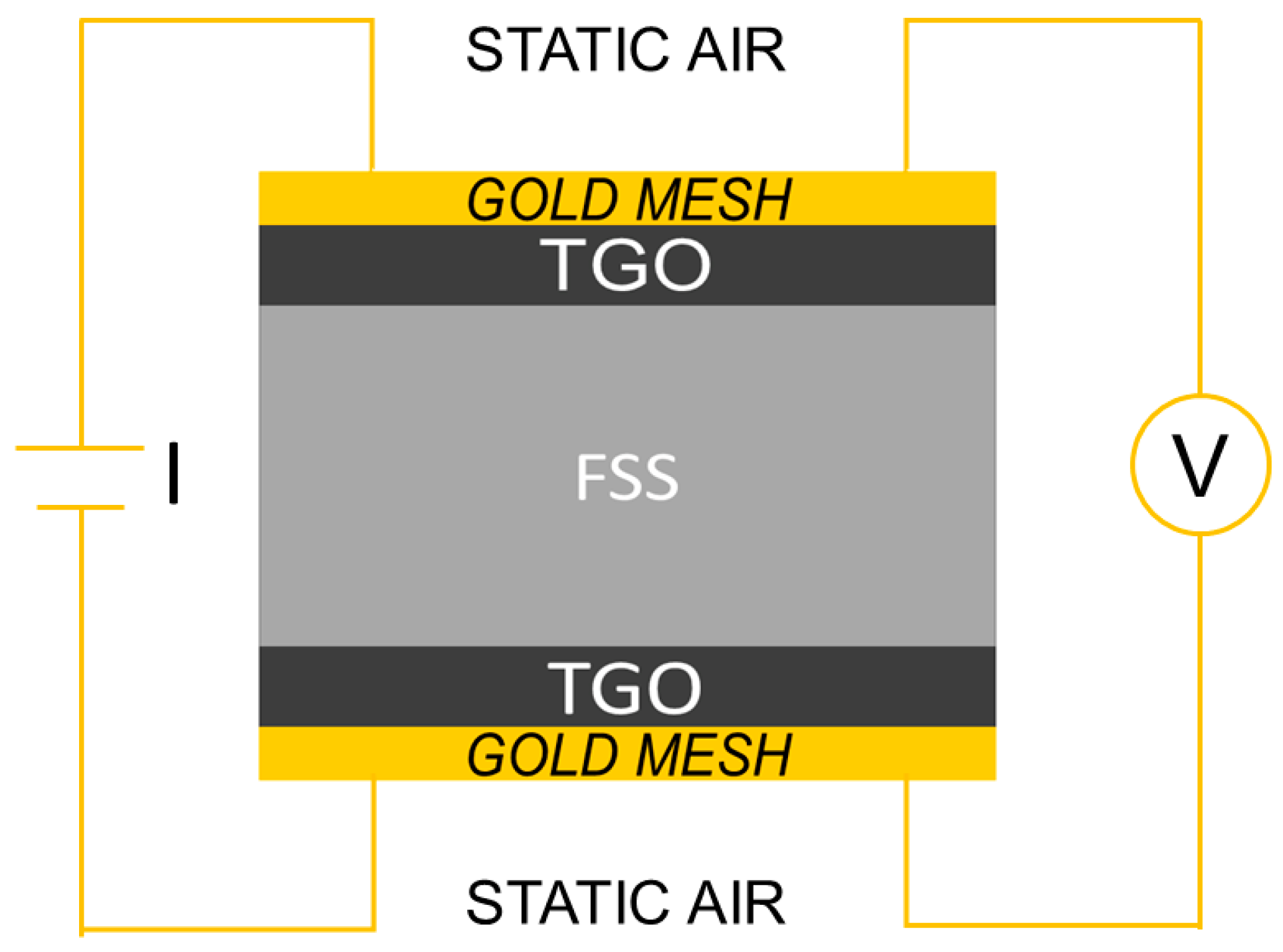
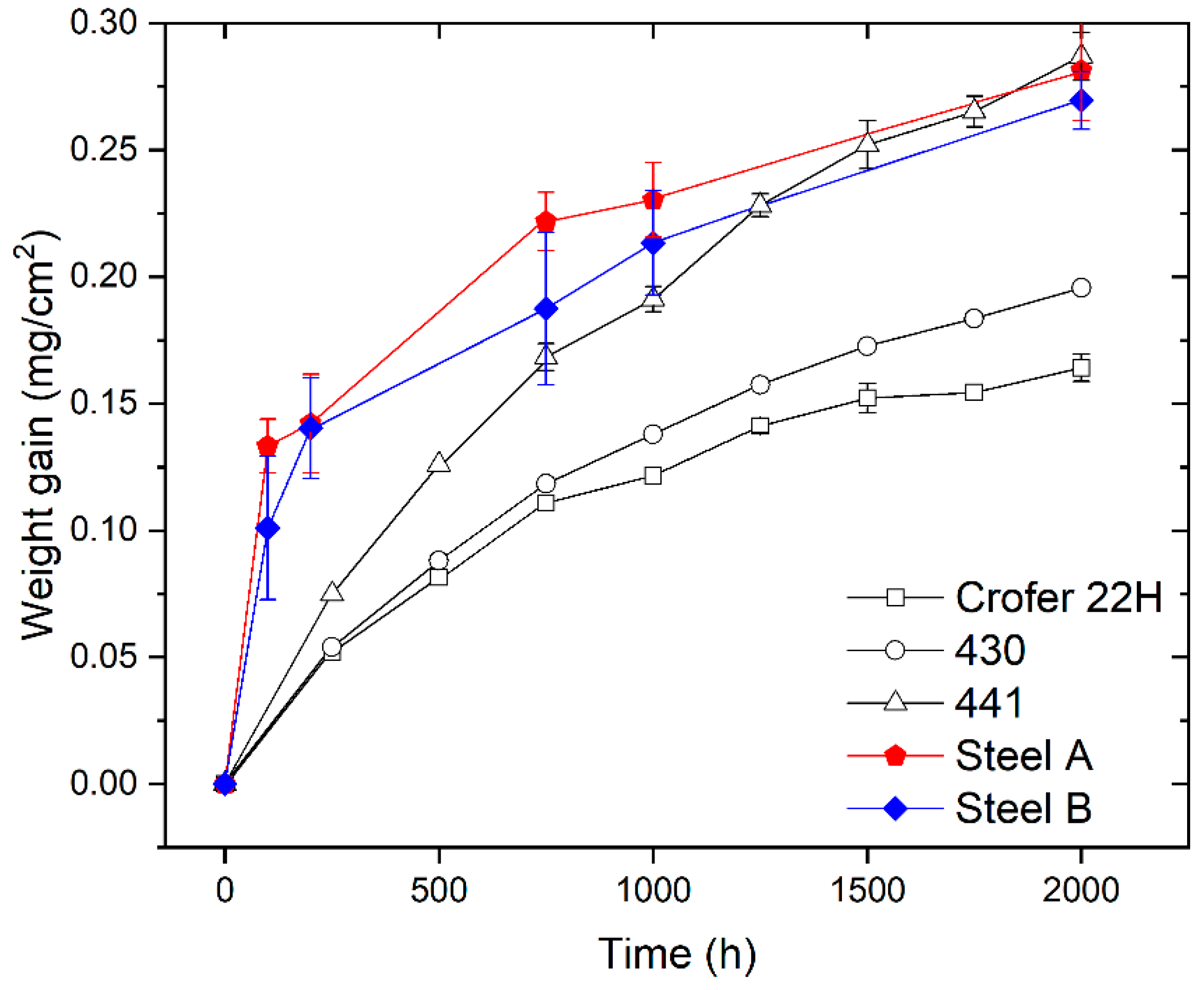

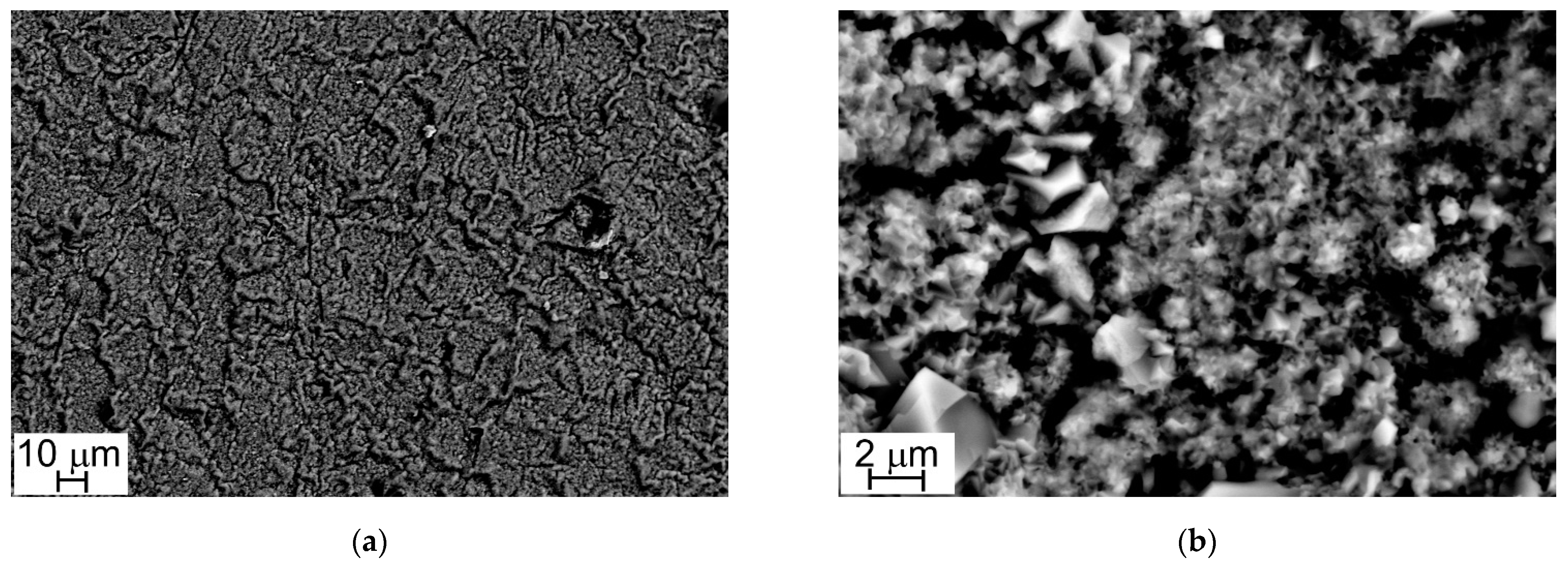
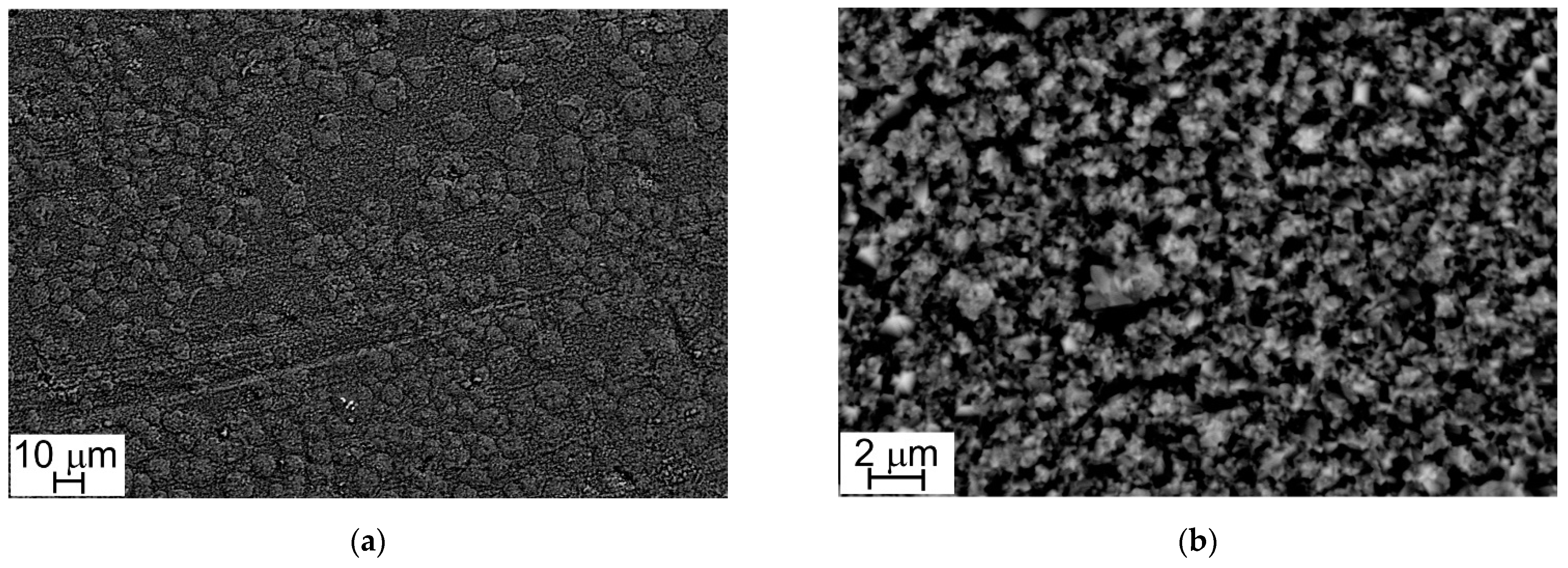
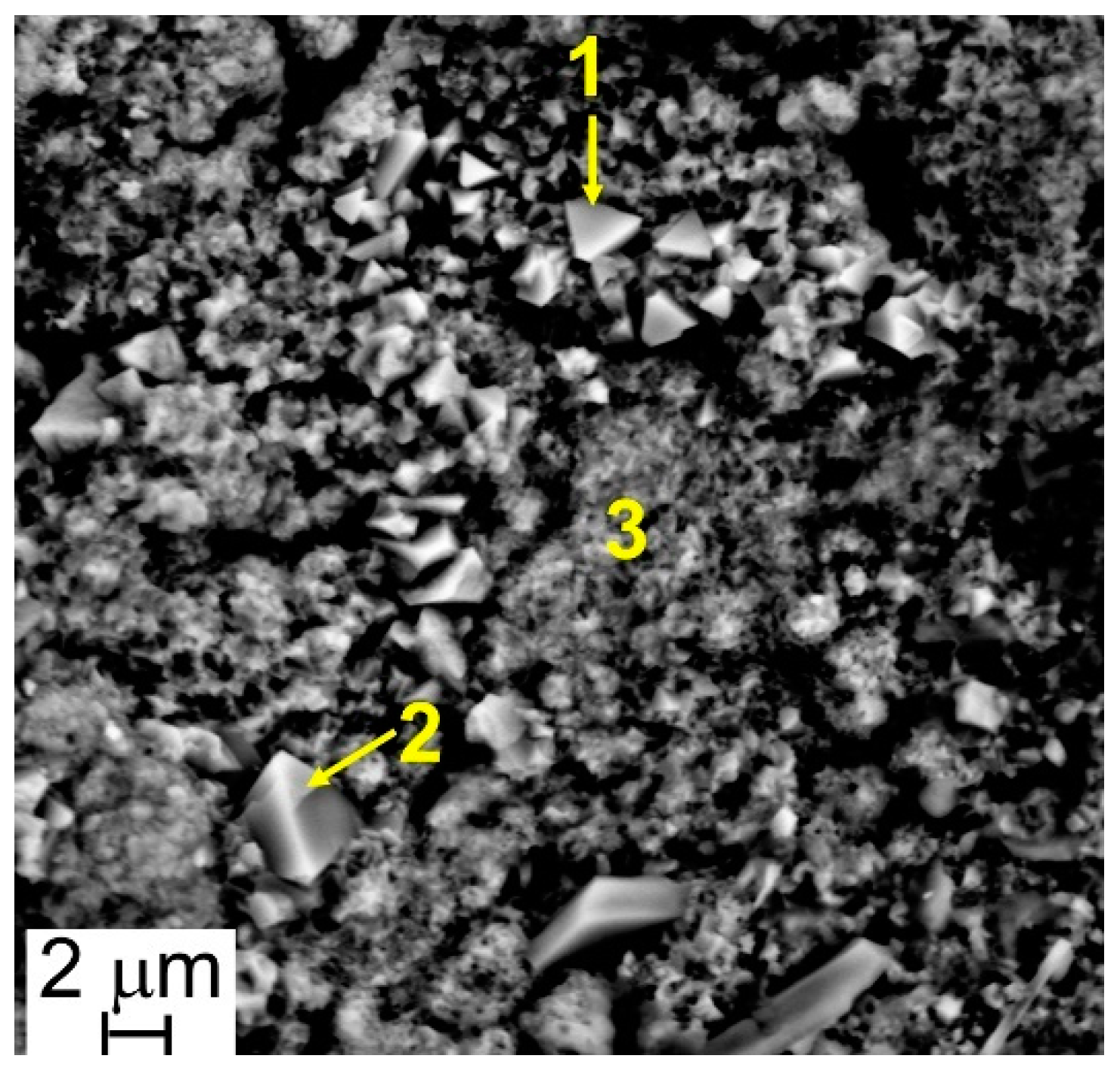
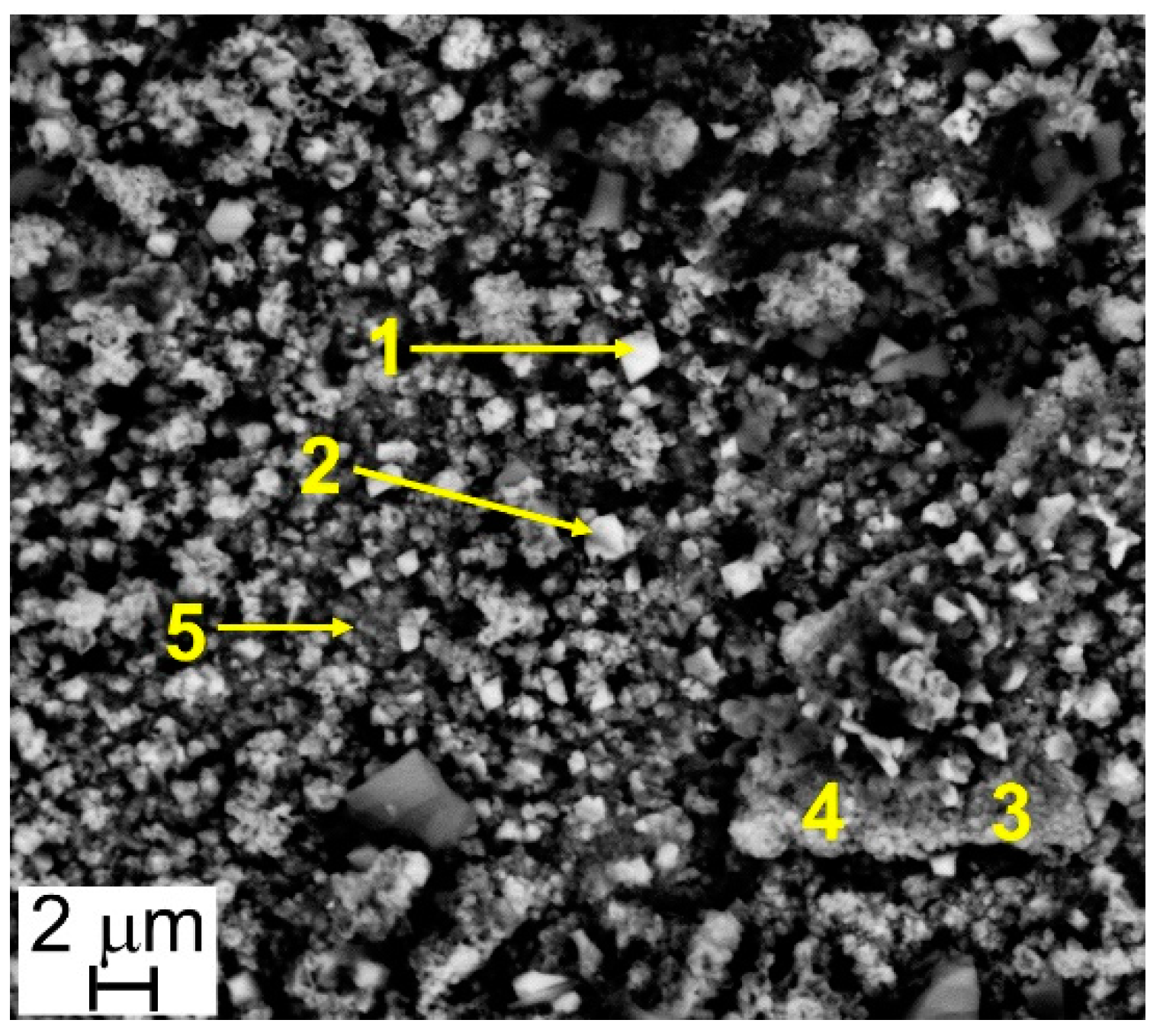
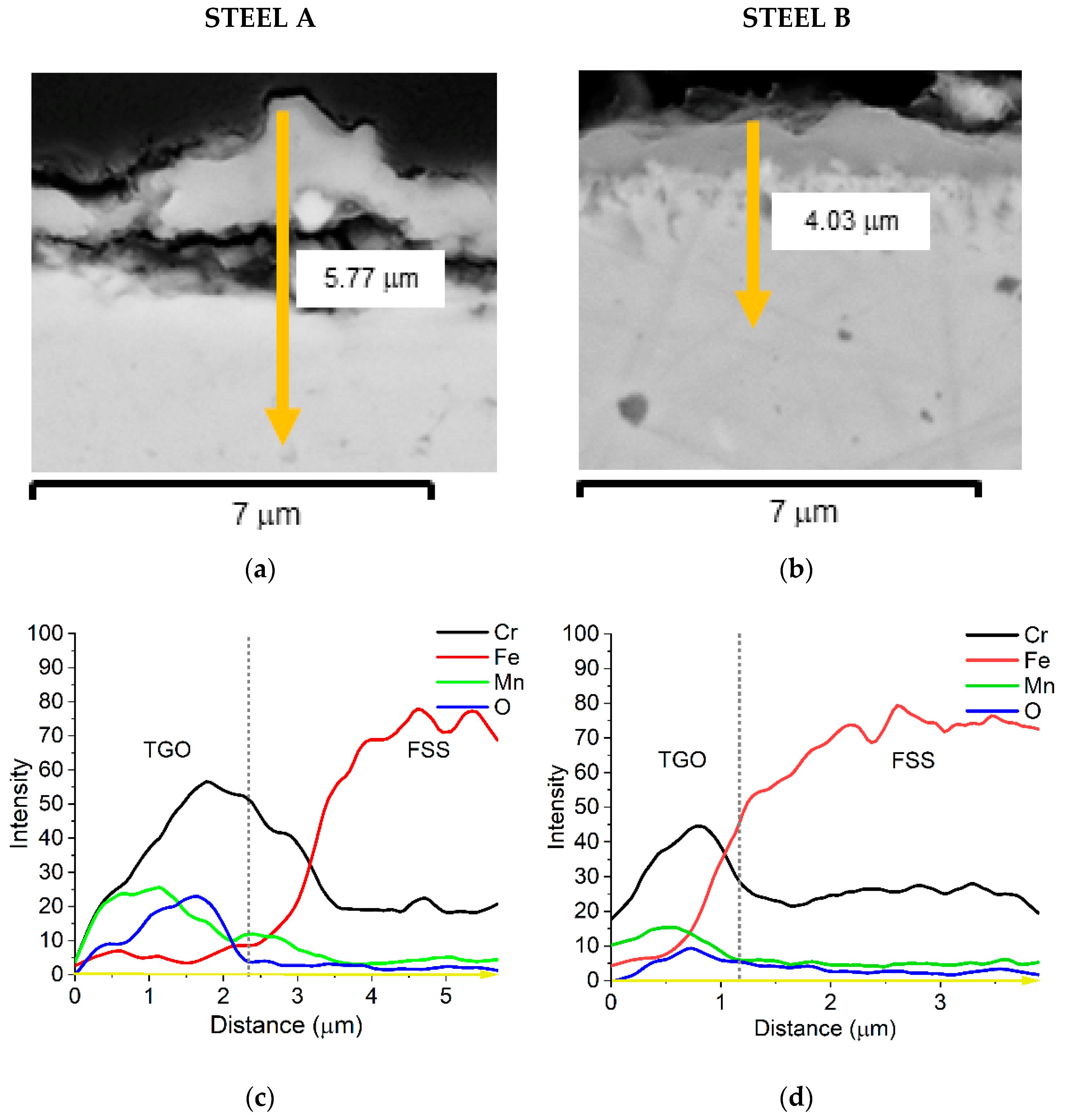
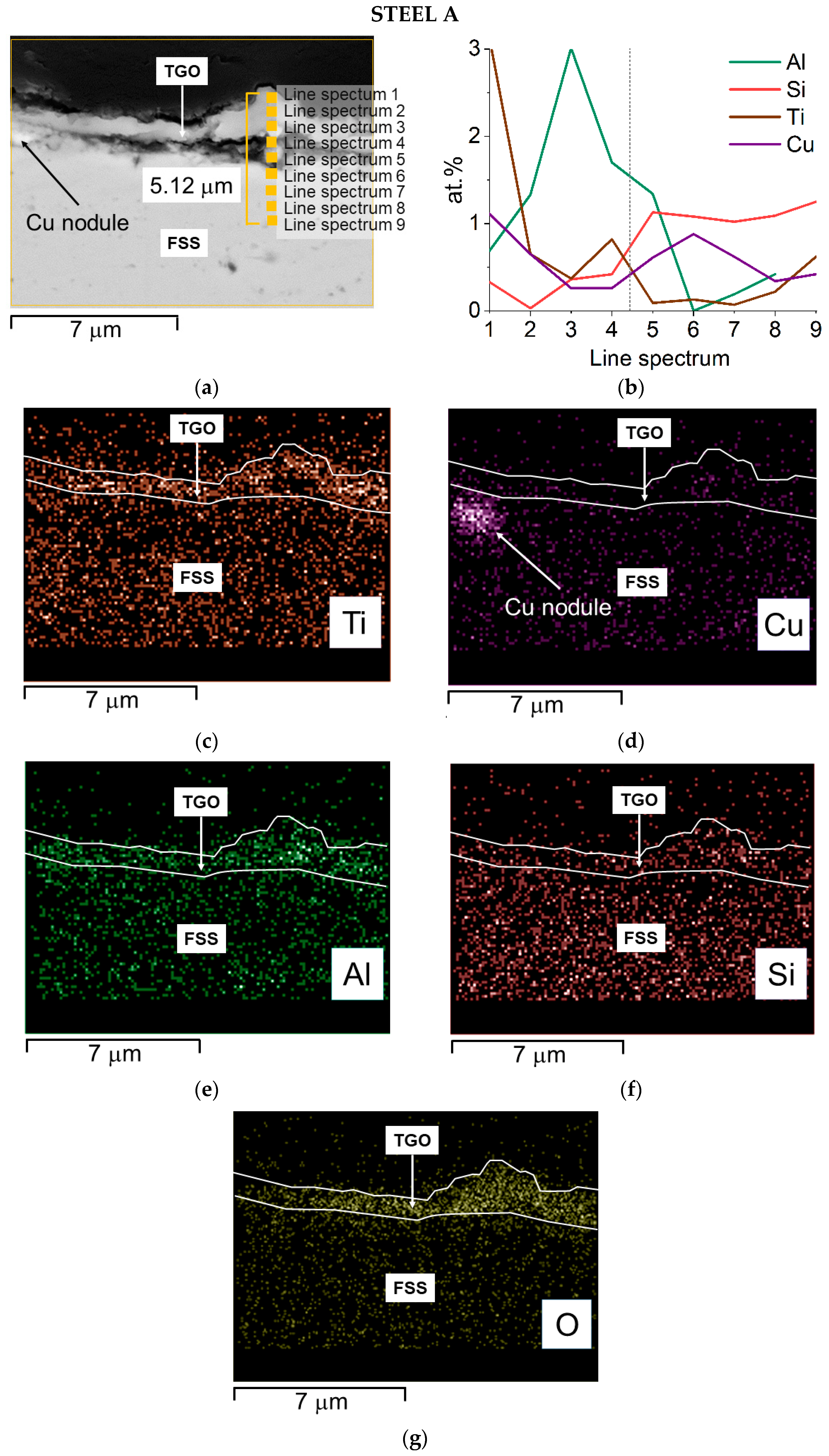
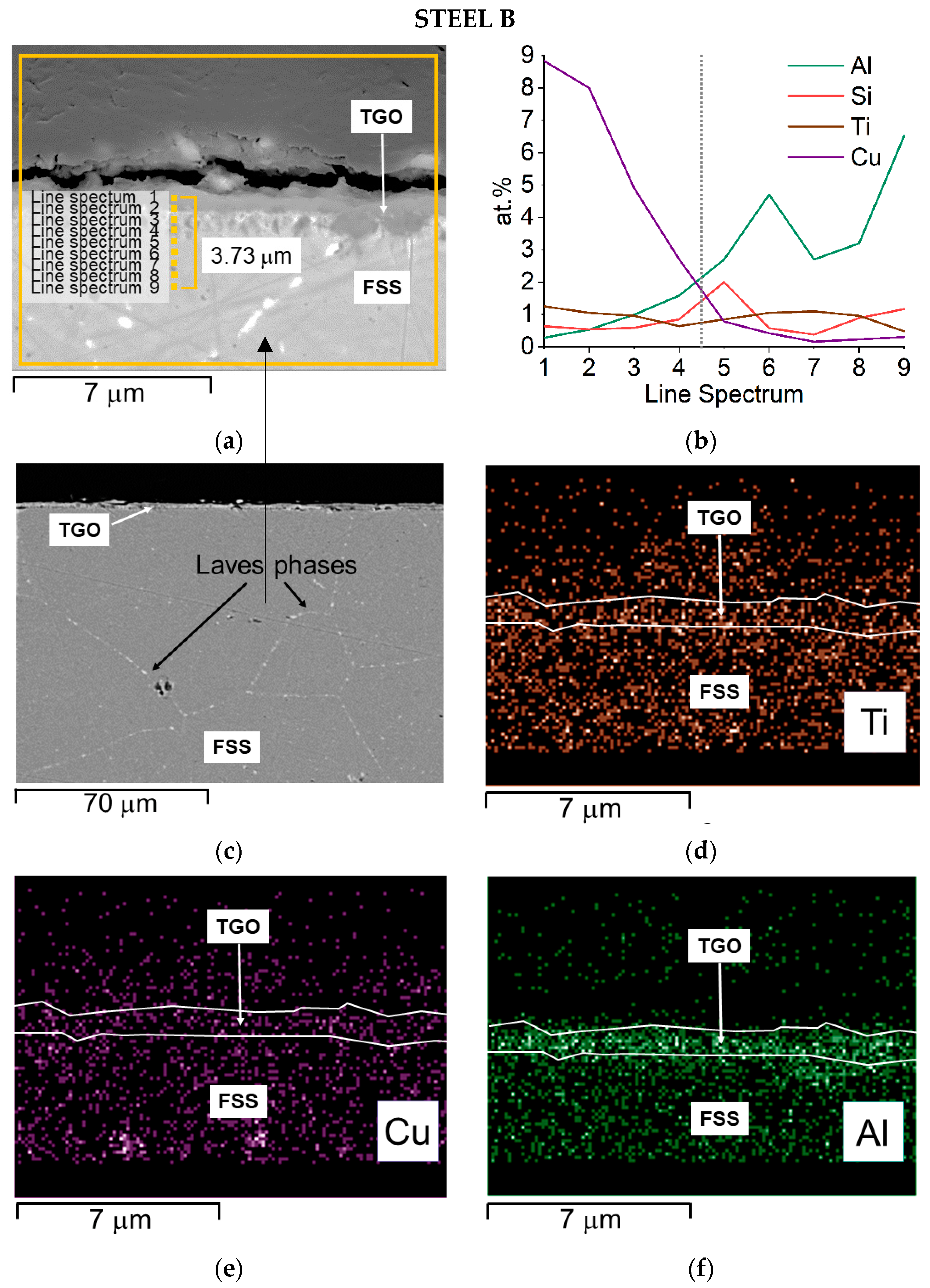
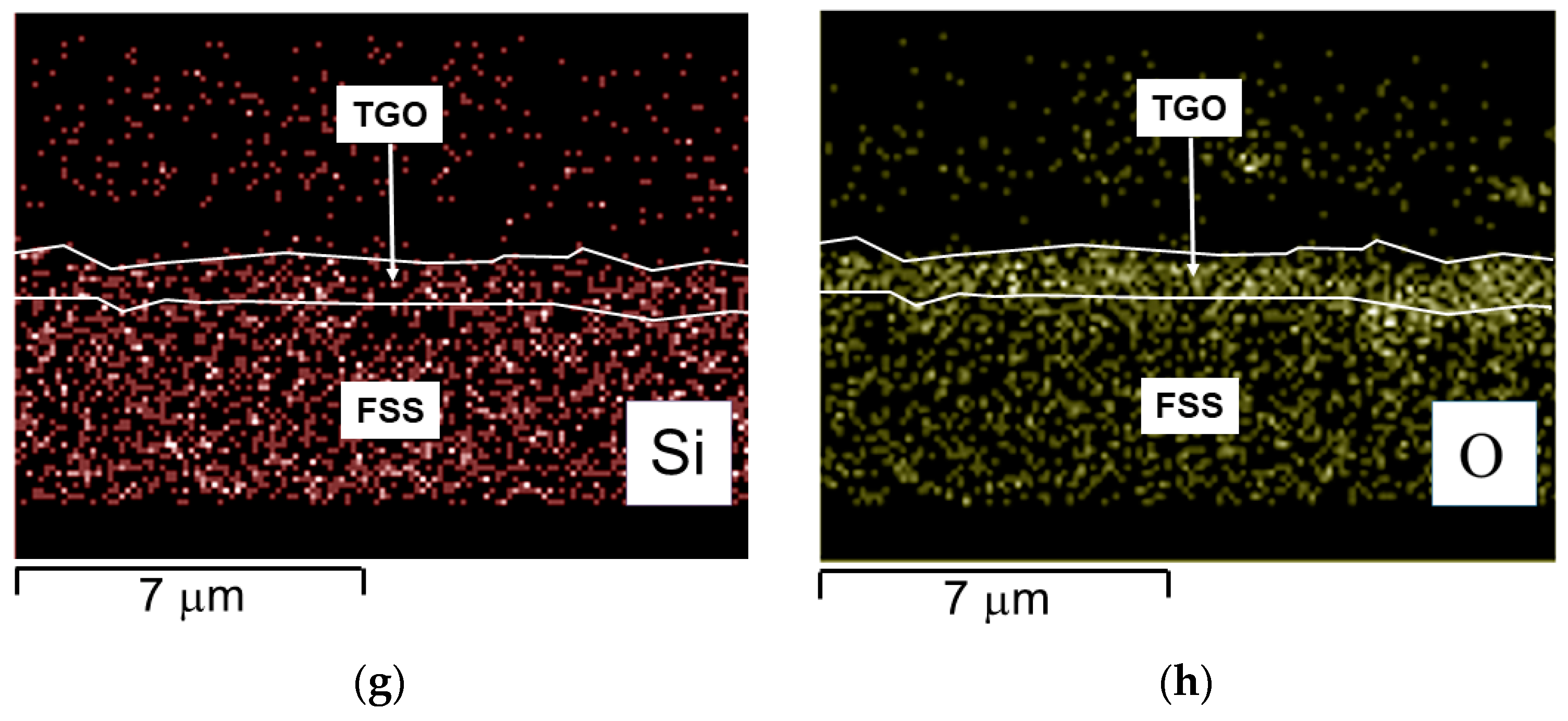
| Samples | Elements | ||||||||
|---|---|---|---|---|---|---|---|---|---|
| Fe | C | Cr | Cu | Mo | Nb | Ti | N | Others | |
| Steel A | Bal. | 0.005 | 14.1 | 1.2 | - | - | 0.18 | 0.010 | <1 |
| Steel B | Bal. | 0.005 | 17.1 | 1.2 | 0.3 | 0.54 | 0.11 | 0.010 | <1 |
| Steels | Kp [g2cm−4s−1] |
|---|---|
| Steel A | 9.0 × 10−15 |
| Steel B | 8.4 × 10−15 |
| Crofer 22H | 3.2 × 10−15 |
| 441 | 1.1 × 10−14 |
| 430 | 4.7 × 10−15 |
| Point | Elements | ||||||
|---|---|---|---|---|---|---|---|
| O | Al | Si | Cr | Mn | Fe | Cu | |
| 1 | 46 | 1 | - | 13 | 20 | 17 | 3 |
| 2 | 52 | - | - | 10 | 21 | 14 | 3 |
| 3 | 54 | - | 1 | 15 | 2 | 28 | - |
| Point | Elements | |||||||
|---|---|---|---|---|---|---|---|---|
| O | Al | Si | Ti | Cr | Mn | Fe | Cu | |
| 1 | 59 | - | - | 1 | 21 | 16 | 3 | - |
| 2 | 55 | 1 | - | - | 16 | 20 | 5 | 3 |
| 3 | 62 | - | 1 | 1 | 26 | 5 | 5 | - |
| 4 | 60 | 1 | 1 | 1 | 26 | 2 | 8 | 1 |
| 5 | 54 | 4 | - | - | 21 | 2 | 16 | 1 |
| STEEL | Main Compounds | |
|---|---|---|
| μ-RS | XRD | |
| A | Cr2O3 MnxCr3−xO4 | Substrate (Fe,Cr) alloy Cr2O3 TiO2 Mn1.5Cr1.5O4 |
| B | ||
| Spectrum | Elements (wt.%) | ||
|---|---|---|---|
| Cr | Mn | Cu | |
| 1 | 23 | 21 | 2 |
| 2 | 32 | 29 | 2 |
| 3 | 32 | 21 | 2 |
| 4 | 34 | 8 | 1 |
| 5 | 35 | 7 | <0.5 |
| 6 | 15 | 1 | 1 |
| 7 | 13 | <0.5 | 1 |
| 8 | 13 | <0.5 | 1 |
| 9 | 13 | <0.5 | <0.5 |
| Spectrum | Elements (wt.%) | ||
|---|---|---|---|
| Cr | Mn | Cu | |
| 1 | 53 | 27 | 5 |
| 2 | 44 | 17 | 8 |
| 3 | 48 | 9 | 4 |
| 4 | 35 | 3 | 1 |
| 5 | 19 | 1 | 1 |
| 6 | 16 | <0.5 | 1 |
| 7 | 16 | <0.5 | 1 |
| 8 | 16 | <0.5 | 1 |
| 9 | 16 | <0.5 | <0.5 |
| 10 | 17 | <0.5 | 1 |
Publisher’s Note: MDPI stays neutral with regard to jurisdictional claims in published maps and institutional affiliations. |
© 2021 by the authors. Licensee MDPI, Basel, Switzerland. This article is an open access article distributed under the terms and conditions of the Creative Commons Attribution (CC BY) license (http://creativecommons.org/licenses/by/4.0/).
Share and Cite
Bongiorno, V.; Spotorno, R.; Paravidino, D.; Piccardo, P. On the High-Temperature Oxidation and Area Specific Resistance of New Commercial Ferritic Stainless Steels. Metals 2021, 11, 405. https://doi.org/10.3390/met11030405
Bongiorno V, Spotorno R, Paravidino D, Piccardo P. On the High-Temperature Oxidation and Area Specific Resistance of New Commercial Ferritic Stainless Steels. Metals. 2021; 11(3):405. https://doi.org/10.3390/met11030405
Chicago/Turabian StyleBongiorno, Valeria, Roberto Spotorno, Daniele Paravidino, and Paolo Piccardo. 2021. "On the High-Temperature Oxidation and Area Specific Resistance of New Commercial Ferritic Stainless Steels" Metals 11, no. 3: 405. https://doi.org/10.3390/met11030405
APA StyleBongiorno, V., Spotorno, R., Paravidino, D., & Piccardo, P. (2021). On the High-Temperature Oxidation and Area Specific Resistance of New Commercial Ferritic Stainless Steels. Metals, 11(3), 405. https://doi.org/10.3390/met11030405








